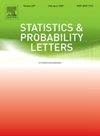三独立同分布随机变量经典中心极限定理的反例完成
IF 0.7
4区 数学
Q3 STATISTICS & PROBABILITY
引用次数: 0
摘要
根据lindeberg - lsamvy中心极限定理,一组相互独立且同分布的随机变量序列的标准化部分和规律地收敛于标准正态分布。众所周知,相互独立不能简化为两两独立,甚至不能简化为三倍独立。对于大多数的边际分布已经构造了反例:最近的一个工程在排除某些原子部分的概率分布的条件下进行,特别是在一个固定的有限集合上几乎所有的分布。在本文中,我们证明了这一条件可以被解除:对于实线上任何方差有限且不集中于单点的概率分布F,存在一个分布为F的三重独立随机变量序列,使得它的标准化部分和规律收敛于一个非正态分布。也有扩展到k元独立性的范围。本文章由计算机程序翻译,如有差异,请以英文原文为准。
A completion of counterexamples to the classical central limit theorem for triplewise independent and identically distributed random variables
By the Lindeberg–Lévy central limit theorem, standardized partial sums of a sequence of mutually independent and identically distributed random variables converge in law to the standard normal distribution. It is known that mutual independence cannot be relaxed to pairwise independence, nor even to triplewise independence. Counterexamples have been constructed for most marginal distributions: a recent construction works under a condition which excludes certain probability distributions with atomic parts, in particular almost all distributions on a fixed finite set. In the present paper, we show that this condition can be lifted: for any probability distribution on the real line, which has finite variance and is not concentrated in a single point, there exists a sequence of triplewise independent random variables with distribution , such that its standardized partial sums converge in law to a distribution which is not normal. There is also scope for extension to -tuplewise independence.
求助全文
通过发布文献求助,成功后即可免费获取论文全文。
去求助
来源期刊

Statistics & Probability Letters
数学-统计学与概率论
CiteScore
1.60
自引率
0.00%
发文量
173
审稿时长
6 months
期刊介绍:
Statistics & Probability Letters adopts a novel and highly innovative approach to the publication of research findings in statistics and probability. It features concise articles, rapid publication and broad coverage of the statistics and probability literature.
Statistics & Probability Letters is a refereed journal. Articles will be limited to six journal pages (13 double-space typed pages) including references and figures. Apart from the six-page limitation, originality, quality and clarity will be the criteria for choosing the material to be published in Statistics & Probability Letters. Every attempt will be made to provide the first review of a submitted manuscript within three months of submission.
The proliferation of literature and long publication delays have made it difficult for researchers and practitioners to keep up with new developments outside of, or even within, their specialization. The aim of Statistics & Probability Letters is to help to alleviate this problem. Concise communications (letters) allow readers to quickly and easily digest large amounts of material and to stay up-to-date with developments in all areas of statistics and probability.
The mainstream of Letters will focus on new statistical methods, theoretical results, and innovative applications of statistics and probability to other scientific disciplines. Key results and central ideas must be presented in a clear and concise manner. These results may be part of a larger study that the author will submit at a later time as a full length paper to SPL or to another journal. Theory and methodology may be published with proofs omitted, or only sketched, but only if sufficient support material is provided so that the findings can be verified. Empirical and computational results that are of significant value will be published.
 求助内容:
求助内容: 应助结果提醒方式:
应助结果提醒方式:


